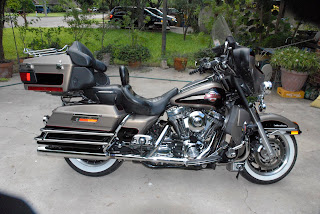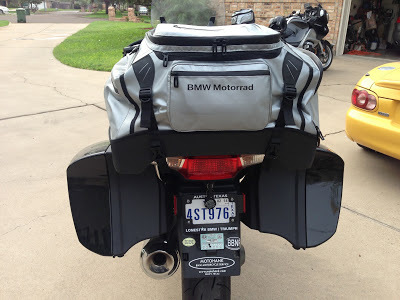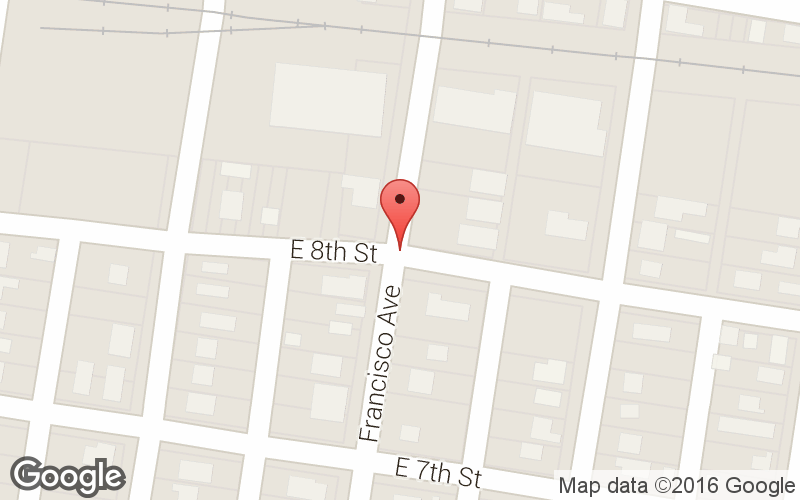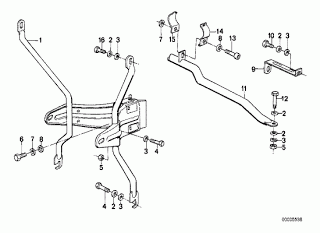Here's an article from 2005 comparing the BMW LT and the Harley Davidson Ultra Classic:
2005 K1200LT vs. 2005
Harley Ultra Classic
I am sitting at home waiting-out Hurricane Emily with not much to do, consequently, as promised, here’s my not so professional comparison of the two motorcycles. I’m doing this because some of the forum members asked me to do this. It’s only my personal opinion and it’s not to start some long drawn-out debate on the issue.
I’ve had the
Ultra about two weeks and have a little under 1,000 miles on it. As some of you know from my earlier posting, I came to the decision of buying an Ultra without much thought process in making the decision. Here’s a summary taken from that posting of what led to my decision,
 |
| My '05 BMW K1200LT |
Well, I'll be signing off the forum, at least as an LT rider, this week. I rode up to Austin to get my new non-working CB radio replaced, but when I got to the dealer I was told that they assumed that it was the relay that was bad on my new CB radio so they had ordered the relay, but not a new CB radio which meant I had to stay overnight to see if they could get one in overnight. I was understanding, but told them that I had to get back home and I wasn't about to make a third trip (660 miles round trip) for the same problem. So I had them remove the CB and credit my account the $768.61 for the CB, Antenna, and Installation. That's about five trips (not including the routine maintenance trips for the 600, 6K, and 12K) that I've had to make for little things (slave cylinder, clutch, communications system, windshield motor, CB, severe front tire cupping, etc.) so all in all, I've traveled about 4K miles or 30% of my riding just for service. I got my bike and took it about a mile down the road and traded it in on a HD Ultra Classic (there's also a dealer about 7 miles from my home). Of course, had I seen a Honda, Ducati, or any other dealer along the way I would have stopped and traded. Impluse buyer is a bad thing. This is my first non-BMW bike (riding since the 60's)...the ride's not as bad as I thought it might be, not as smooth, quick, or powerful as the LT and I miss my LT brakes, but it sure is easier to handle than the LT (imho) and riding two-up doesn't create that LT stress of having to really focus on my stops, go, and turns (granted that's caused by my lack of skill). Maybe I'll get a GS for solo riding? Anyway, I'll miss all the great input from most of you and the expert knowledge you shared with me. Maybe we'll see each other down the road as I putt-putt along. Thanks, and Happy Trails To You!
My brother, an old BMW and currently a Honda ST rider, showed up at the house as soon as he heard the news that I had a new bike. When he walked in I was at the kitchen table checking out the tool kit which comes standard with the Ultra. They look okay, but not exactly what I would call “Snap-On” quality. Right away, my brother says, “Isn’t it thoughtful that Harley makes every combination wrench capable of opening any ‘long neck’ beer bottle!” Without skipping a beat, he added, “I suppose this was included as a complimentary gift”, as he eyed the unopened bag of Pork Rinds on the table. I’m the kid brother, and like my older brother, I grew up only on BMW bikes so his comments were “textbook” and about what I expected. Of course, his critical comments didn’t stop him from taking it on a ride. He called about an hour later saying he stopped at his house for a bit and would bring the bike back in a few days. Later that evening, when he finally returned the bike, he admitted that he’s fond of anything with two wheels, including the Ultra!
So, what do I think? What follows is my personal opinion and there may be some truth in it, but don’t count on it.
Type of Riders: Most of the LT riders I know (not too many) are in technical professions such as engineering. Harley Ultra riders, unlike popular opinion, are not marauding crusaders looking for the closest topless bar, but more like your typical dentists or gynecologists.
Seat: The LT seat is too narrow up front and I get that “monkey butt” feeling after a few hundred miles. The Harley seat is much more comfortable. Advantage to the Ultra.
Sitting Style: The LT sitting style, like all BMWs, is very upright compared to the Ultra. The Ultra is more laid-back with your feet forward. I still get on the Ultra trying to look for the gear and break pedals in the BMW position. I’ve only taken two rides over 300 miles, but both times I haven’t found myself squirming around the seat with the “monkey butt” I get on the LT stock seat. The forward feet configuration is also fairly relaxing on those long rides. I give the edge to the Harley.
Controls: The controls on the LT are much more ergonomically situated compared to the Ultra. The Ultra controls are in about the same place, but I really liked the turn signal controls on the LT. A neat feature on the Ultra is self-canceling turn signals. Of course, with the Harley you don’t find yourself fumbling around for the windshield control either! I do like the Harley rocker controls on the fairing; they seem to be in a logical place and are easy to rock on/off as needed. Edge goes to the LT.
Foot pegs: Not a good comparison since the LT has pegs and the Ultra has massive floor boards which seem to have enough room to carry a case or two. The boards are mounted on some type of springs so that you get no vibration. They’re neat, advantage Ultra.
Windshield: I had the tall windshield on the LT and although I’m 5’10” I still found it to be too tall even at the lowest position to get much air in “stop and go” riding. The motor went out on the LT and had to be replaced under warranty (still an extra 660 mile round trip return to the dealer to get it replaced since no part in stock). The Harley windshield is a good height, but it’s a fixed windshield without the convenience of being able to lower/raise it. Advantage LT.
Gauges: The LT digital display is good, but the LCD is hard to see in the sun which, except for this hurricane pause, is plentiful in south Texas. The Harley has analog type display for speed and RPMs and LCD for Radio. I measured the accuracy of each speedometer against my friend’s GPS (riding side-by-side) and the LT was about 5mph off (reading 80 at 75) and the Harley was accurate (reading 70 at 70). The low fuel, oil, and fuel injection lights on the Harley are very small and hard for me to see (I wear glasses) compared to the LT. I give the advantage to the Harley because I appreciate an accurate speedometer.
Trunk & Side Bags: The Ultra has much more space than the LT (haven’t measured it, just eyeball judgment). I like the Ultra top case. It has lots of room and is much wider than LT trunk so it’s much easier for me to find stuff. I’ve taken the LT trunk off (with Ztechnik rack) and it weighs exactly 30lbs. I don’t know how much the Harley trunk weighs, but it’s construction is not double walled and has to be much lighter (good for keeping that low center of gravity [cog]). The Ultra comes with bag liners as standard equipment. Of course, the central locking system is great on the LT. The locks on the Ultra do they’re job of keeping things closed, but they don’t seem like they can keep any determined thief from easily breaking the lids open. Edge goes to the Ultra.
Gas Tank & Refueling: The LT tank is holds about a gallon and half more than the Ultra (5 gallons) so you travel further than the Ultra on one tank with the LT. The gauges
on both the LT and the Ultra (analog) seem to be accurate. I’ve taken both to near fume levels and both read accurate. Of course, as mentioned above, the “low fuel warning” light on the Ultra is about the size of the period at the end of this sentence. Refueling the Ultra is much easier than on the LT. Both bikes have the lid and then the screw-off cap. As you know, the LT is on the right side and I always found it a bit troublesome to stop by the pump, with the pump on the right side also, take off my helmet, putting it between the handlebars and the “on/off” key then remembering that I need the key to unlock the lid (small inconvenience which can be avoided by thinking ahead). If I remembered to get the key first then I had to be careful when swinging the handlebar to the left so I can open the gas lid without dropping the helmet. Once the lid is open the little rubber thing that is suppose to hold the gas cap while refueling never really held it in place. The Harley presents none of those small inconveniencies since the lid and cap are in the center of the tank so you can park on either side of the pump and it’s easy to fill it to the brim. Edge to the Ultra.
Fairing: The LT glides through rough winds and it really takes high speed curves well. The Ultra with its “batwing” fairing mounted on the front handlebars and forks is not as stable at high speeds and I found when taking a curve at over 70mph you really need to pick a line and stick to it otherwise I get an uncomfortable wavy feeling. The Harley with the “batwing” fairing and it now comes with new little clear plastic wings for added wind protection. Additionally, it also has the “lowers” for fuller wind coverage. The LT is one piece and great protection (I haven’t hit a hard rain on the Ultra, but it can’t be as good as the LT).Edge goes to the LT.
Lighting: The lights on the LT are anemic (I had the Xenon HID lights added) and the Ultra’s “Spot” lights are very good for stock stuff. Taillights are about the same, but I haven’t given them much thought. The LT floor lighting is very nice, but not essential to me. Edge goes to the Harley.
Side-stand: The LT side-stand is not much to brag about, but then neither is the non-existing center-stand on the Harley. The electrical stand on the LT is great, but to me a little too low, esp. when traveling in Mexico with all its topes (speed bumps). The Harley stand is very sturdy, sturdy enough for my wife to get on the bike with the side-stand down and not have me cringe. It also leans way over, kind of scary way over, but it sits fine and won’t roll off the stand, either forward or backward. It doesn’t look like the wind will topple the Harley. Those two things are welcome additions, advantage Harley.
Heat: The Harley does put out some noticeable heat in city traffic, but that a good thing in cold south Texas! Advantage goes to the LT.
Dropping: I rolled the LT down twice, once on each side the first month I got the bike, but the damage to the bike was only some small scrapes on the “wing” plastic and it was on the underside where it wasn’t noticeable (side bags did not touch). I haven’t dropped the Harley (knock on wood), but it has a roll bar on the “lowers” and rails around the saddle bags, but it sure doesn’t look like it can handle any type of drop without significant damage. Advantage LT.
Brakes: I miss my ABS and power servo brakes on the LT, although the Harley does stop much better than I thought. Big advantage to the LT.
Front Fork: The LT handles better up front, but the Ultra doesn’t give you that sick feeling in your stomach when you press the front brake lever going at a slow speed and having your wheel turned. Advantage to the Harley.
Suspension: It’s much better on the LT. You feel the bumps and those uneven asphalt to cement seams on overpasses. Advantage to the LT.
Tires: Since I had severe cupping on my stock stone which caused a frightening front end wobble (with hands off the handlebars), I give the advantage to the yet (only 1K miles) untested Dunlops. Advantage to the Harley.
Accessories:
a) Standard: The Ultra comes with the bag liners and that’s very nice. I had to purchase the Kathy liners for the LT. The LT came with a tool kit (I’ve heard that they are no longer standard equipment) and the Ultra also has a kit. I don’t think either one is top quality. The LT had the tire repair kit and the Harley does not. The Harley has the CB (with antenna) as standard on the Ultra Classic and it’s not on the LT. I’m sure I’m forgetting lots of things, but if they don’t come to mind then they can’t be that critical. Advantage goes to the Ultra.
b) Optional: To me the LT comes about as loaded as you can get a bike except for the lights. The Harley stores I’ve seen can turn the Ultra into a solid piece of chrome with only bucks getting in the way. I don’t like the fact that everyone pushes the Harley upgrade (at least Stage I: new air intake, computer chip, and exhaust for an extra 2HP maybe at the $700 range) before you even get out the door. Edge goes to the LT.
Power: Of course, the LT. I don’t know if I’ll get that Stage I yet on the Harley. The stock engine seems like it can handle most things. Being from the BMW family, I’ve keep the rpms over 2K so as not to lug the engine. It doesn’t give you that great Harley “potato” sound with the engine revved up a little, but I can’t think of anything worse than lugging an engine.
Acceleration: Here again, the LT. I’ve only taken the Harley to 85mph and it’s okay, but seems happiest at 70mph.
Smoothness: The LT. I always thought the Harley was a very rough ride just from seeing guys at stops with all the vibrating, but amazingly, the Ultra is smooth enough for me at highway speeds.
Handling:
a) Slow speed handling: To me the Harley is miles ahead in this department. Compared to the LT, the Harley is like riding a bicycle. Edge Harley.
b) Fast speed handling: As mentioned above advantage to the LT.
c) Riding two-up: The Harley is much easier to me. My wife noticed right away that I was much less stressed out on the Harley than the LT, especially in stop and go traffic. Advantage Harley.
d) Non-paved roads: The little I’ve done on the Harley is enough to give the edge to the Harley. It feels a little more grounded. Edge to the Harley.
e) Two-up comfort: My wife says the LT is more comfortable. She told my son that riding on the LT is like riding in our Mercedes, but that the Ultra is not bad and, “hey, it a motorcycle, adapt and get used to it”. What a gal! Advantage to the LT.
f) Overall feel: The LT is a beast to stop and go, you get used to it, but you never dismiss it. The Harley is just the opposite; it’s easy to stop and go, esp. two-up. The LT feels long on the road and the Harley feels short and stubby
(whatever that means). Consequently, the LT ride is smoother with turns and leaning feeling a bit more solid than the Harley which feels quicker. To me, this is a toss-up with the slow speed feel going to the Harley and Highway speeding to the LT.
Appearance: The Lt looks sleek and modern and the Harley looks retro. Having taken the Tupperware off numerous times I know it’s a pain which you don’t have with the Harley. Conversely, it’s a pain to wash the Harley (haven’t done it yet, but it looks like it is) compared to the LT. It’s all a style thing so it doesn’t matter which I think is better…it’s more of a trying to compare apples with oranges.
Conclusion: Well, grasshopper, would I do it again? I never really ridden a Harley too much and I really was amazed at how easy it handles compared to the LT in traffic and in stop and go situations. Sure it’s not as sleek, powerful, or smooth as the LT, but when I get up in the morning and say, “let’s go for ride” without thinking about it, where as in the past, I would really think of “a ride” as an event which I had to “think” about and think about where I was going and what obstacles I would encounter. That intangible is worth making the move.
I know I’d still have the LT if I could get local service, but I can’t and a 600 mile ride for service and to be told “we don’t have the part in stock” is not too practical for me. I’m still going to look at the GS for riding to the Big Bend country which I visit a few times a year!
 |
| My '05 Harley Ultra Classic |
…gotta go, water’s rising and I have a leak in the sunroom!




























































































